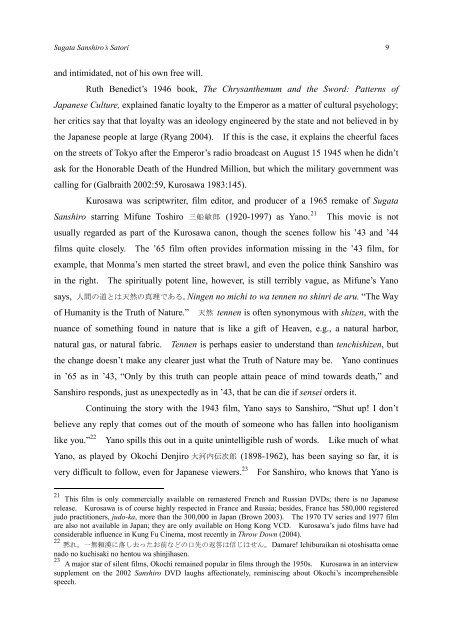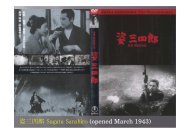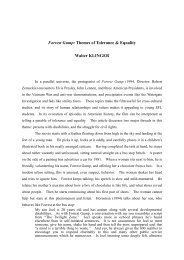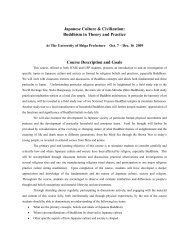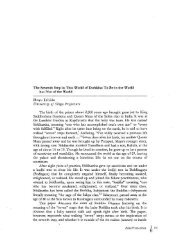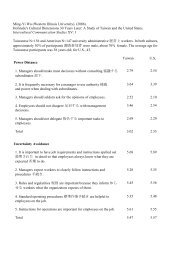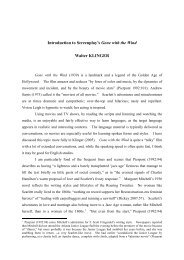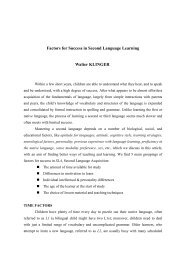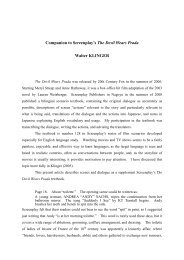You also want an ePaper? Increase the reach of your titles
YUMPU automatically turns print PDFs into web optimized ePapers that Google loves.
<strong>Sugata</strong> Sanshiro’s <strong>Satori</strong> 9and intimidated, not of his own free will.Ruth Benedict’s 1946 book, The Chrysanthemum and the Sword: Patterns ofJapanese Culture, explained fanatic loyalty to the Emperor as a matter of cultural psychology;her critics say that that loyalty was an ideology engineered by the state and not believed in bythe Japanese people at large (Ryang 2004). If this is the case, it explains the cheerful faceson the streets of Tokyo after the Emperor’s radio broadcast on August 15 1945 when he didn’task for the Honorable Death of the Hundred Million, but which the military government wascalling for (Galbraith 2002:59, Kurosawa 1983:145).Kurosawa was scriptwriter, film editor, and producer of a 1965 remake of <strong>Sugata</strong>Sanshiro starring Mifune Toshiro 三 船 敏 郎 (1920-1997) as Yano. 21 This movie is notusually regarded as part of the Kurosawa canon, though the scenes follow his ’43 and ’44films quite closely. The ’65 film often provides information missing in the ’43 film, forexample, that Monma’s men started the street brawl, and even the police think Sanshiro wasin the right. The spiritually potent line, however, is still terribly vague, as Mifune’s Yanosays, 人 間 の 道 とは 天 然 の 真 理 である。Ningen no michi to wa tennen no shinri de aru. “The Wayof Humanity is the Truth of Nature.” 天 然 tennen is often synonymous with shizen, with thenuance of something found in nature that is like a gift of Heaven, e.g., a natural harbor,natural gas, or natural fabric. Tennen is perhaps easier to understand than tenchishizen, butthe change doesn’t make any clearer just what the Truth of Nature may be. Yano continuesin ’65 as in ’43, “Only by this truth can people attain peace of mind towards death,” andSanshiro responds, just as unexpectedly as in ’43, that he can die if sensei orders it.Continuing the story with the 1943 film, Yano says to Sanshiro, “Shut up! I don’tbelieve any reply that comes out of the mouth of someone who has fallen into hooliganismlike you.” 22 Yano spills this out in a quite unintelligible rush of words. Like much of whatYano, as played by Okochi Denjiro 大 河 内 伝 次 郎 (1898-1962), has been saying so far, it isvery difficult to follow, even for Japanese viewers. 23 For Sanshiro, who knows that Yano is21 This film is only commercially available on remastered French and Russian DVDs; there is no Japaneserelease. Kurosawa is of course highly respected in France and Russia; besides, France has 580,000 registeredjudo practitioners, judo-ka, more than the 300,000 in Japan (Brown 2003). The 1970 TV series and 1977 filmare also not available in Japan; they are only available on Hong Kong VCD. Kurosawa’s judo films have hadconsiderable influence in Kung Fu Cinema, most recently in Throw Down (2004).22黙 れ。 一 無 頼 漢 に 落 し 去 ったお 前 などの 口 先 の 返 答 は 信 じはせん。Damare! Ichiburaikan ni otoshisatta omaenado no kuchisaki no hentou wa shinjihasen.23 A major star of silent films, Okochi remained popular in films through the 1950s. Kurosawa in an interviewsupplement on the 2002 Sanshiro DVD laughs affectionately, reminiscing about Okochi’s incomprehensiblespeech.


